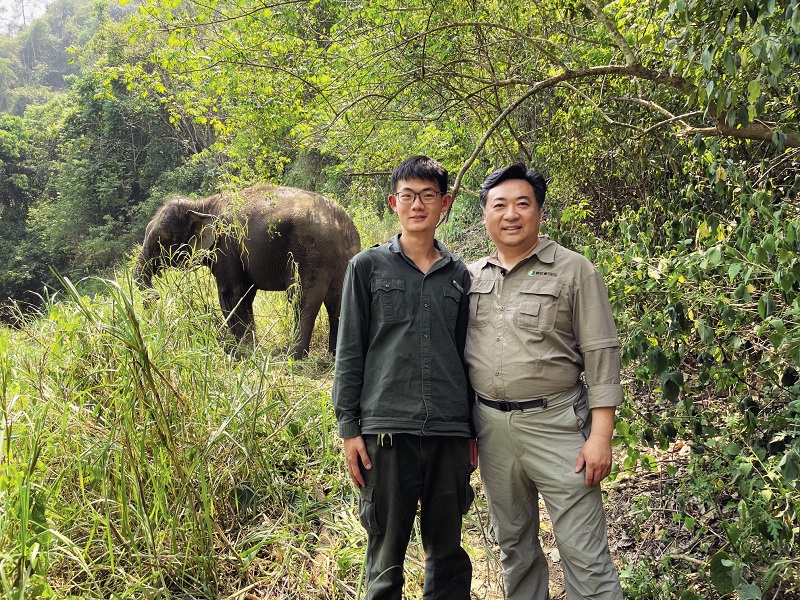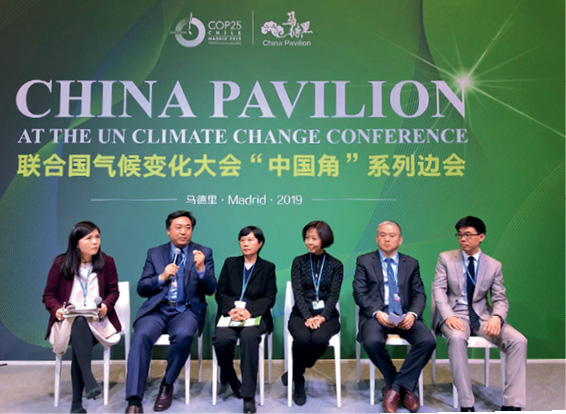In March 2020, a herd of wild Asian elephants left a forest nature reserve in Xishuangbanna, southwest China’s Yunnan Province, and trekked some 500 kilometers northward to Pu’er, and then to Yuxi and Kunming. Many people may wonder, “Why did these wild animals travel all the way to the north, through forests, farmland, villages, and even cities?”
“The migration of elephants is a normal phenomenon. They were not merely moving northward, but also westward and southward,” said Zhang Li, member of the Endangered Species Scientific Committee of China and a professor with the College of Life Sciences at Beijing Normal University. Zhang, together with his team, has been to almost all nature reserves in Yunnan since 1999, devoting himself to the research of wild Asian elephant populations in China.

Zhang Li (first, right) has a photo taken at the Wild Elephant Valley in Xi-shuangbanna with Zhou Fangyi, who has been working for the protection of wild elephants at the Asian Elephant Rescue and Breeding Center ever since his graduation.
Striking a Balance
Yunnan is known as a treasure trove of biodiversity in China, and Xishuangbanna is a bright pearl of the treasure trove. Endangered species like Asian elephants and green peacocks are living in almost 2,400 square kilometers of tropical rainforest in Xishuangbanna.
As early as 1988, the Law of the People’s Republic of China on the Protection of Wildlife came into force, which adopted strict measures for the protection of endangered species. “The number of wild Asian elephants in Yunnan has doubled to more than 300 from around 150 in the late 1970s,” said Zhang, giving the credit to the great efforts in wildlife conservation.
Over the past four decades, China has built more than 2,800 nature reserves and close to 10,000 protected areas of all types and at all levels. Last October, China announced, during the 15th meeting of the Conference of the Parties to the Convention on Biological Diversity (COP15), the formal establishment of the first batch of five national parks, and a system of protected areas with national parks as the mainstay, supported by nature reserves and supplemented by nature parks. Equal emphasis is put on the survival and development of local communities, and the protection of biodiversity and endangered species. There are more policies in place, including major ecological restoration projects and the setting of ecological conservation red lines.
However, the contradiction between economic growth and environmental protection still exists. “Due to climate change and economic activities, suitable habitats for wild animals outside nature reserves are shrinking,” said Zhang, pointing out that this was the main reason for elephants’ migration.
Climate change, with its huge impact on the geographical distribution of species, is the major reason for the loss of biodiversity, forcing wildlife to find other habitats. According to Zhang, an environment in which one or more species survive is called a habitat. Habitat loss — the disappearance of natural environments that are home to particular plants and animals — has posed the greatest threat to biodiversity; yet climate change is exacerbating this process, causing the destruction, degradation, and fragmentation of natural habits. In addition, frequent extreme weather events due to climate change is another factor causing damage to biodiversity.

Zhang Li (second, left) attends the China Pavilion at the UN Climate Change Conference held during the 25th Conference of the Parties to the United Nations Framework Convention on Climate Change in 2019.
Nature-Based Solutions
Migrating elephants have actually played many roles. They were not just destroyers of agricultural crops, but also contributors to carbon sequestration. They also help disperse plant seeds and fertilize fields.
Part of the carbon in the plants eaten by elephants can be converted into energy, while the substantial part is excreted from the body in the form of residues of plant stems and fruit shells, which will be turned into peat and then fixed in the soil, said Zhang. The eaten plants, consequently, provide more space for new plants, allowing the rainforest to grow faster. In this case, elephants play a crucial role in safeguarding the entire ecosystem and its biodiversity, as they help to achieve a carbon-neutral status.
What is carbon neutrality? It is when the amount of carbon released into the atmosphere is balanced, or offset, by the amount of carbon taken out. Why it is so important? Because carbon dioxide is the primary greenhouse gas emitted through human activities that contributes to global warming.
Meanwhile, the tropical and monsoon rainforest that elephants survive in play an effective role in carbon sequestration. The carbon-dense tropical rainforest is a huge carbon sink, as it stores more carbon than it emits, making it capable of fixing 81 tonnes of carbon dioxide per hectare per year. “All industries are implementing the policies of carbon emission reduction and carbon trading. In the future, we may rely on this huge carbon sink to achieve the goal of carbon neutrality,” said Zhang.
There are still many villages located in the tropical rainforest protected areas, where local villagers make a living by planting tea and rubber. Covering an area of more than 9,500 hectares, the planted area is less than 10 percent of the protected areas. If the rainforest disappears, the ecosystem will no longer be complete. An incomplete and unhealthy ecosystem will lose its economic value, and its carbon sink value drops. It is, therefore, an urgent and rewarding job to protect the rainforest, as it guarantees the stable and sustainable development of the local society and economy.
An effective way is the Nature Based Solutions (NBS). This approach uses natural systems to provide critical services. For example, wetlands are used to release flood water, and mangroves to mitigate the erosion of waves and storm surges on the coastal area. It is designed to protect and restore ecosystems so as to address emerging challenges, such as climate change, natural disasters, food and water shortages, and thus improve the well-being of human beings.
“NBS represents a cutting-edge concept in the world for ecological protection and restoration,” said Zhang. Advocating harmonious coexistence between humans and nature, NBS aims to build a social and economic system that respects nature and pursues green and low-carbon development, to tackle climate change and achieve sustainable development goals in an effective manner, Zhang added.
By its very nature, NBS is to develop a nature-friendly economy. Zhang gave another example. In 2018, scientists made a quantitative assessment of the value of the work on giant pandas conservation. The result showed that the conservation has been effective. According to the assessment, every US $255 million spent on giant pandas annually can generate a handsome return of US $2.5 billion. “The conservation work has generated great value for local people, culture, and the environment, as it enhances the value of soil and hydrological resources, and brings in considerable tourism income,” he said.
“Natural conservation is not a matter of just investing money with no other benefits. Its economic value is measurable,” said Zhang. “Lucid waters and lush mountains are invaluable assets.” This is not just an empty slogan. It has been proved that a good natural ecological environment lays the foundation for stable and sustainable development.
A Joint Effort
In China, the long-term promotion and implementation of nature-based solutions is no longer a top-down endeavor led by the government, but has been gradually transformed into a cooperative approach with participation from multi-stakeholders. Zhang is now wearing a new hat as the director of the promotion center for carbon neutrality funded by Green Inclusive, a company providing digital solutions to carbon emission reduction.
“If forest carbon sequestration is a method of carbon emission reduction on the production side, then a carbon ledger for individuals is another way of reduction on the consumer side,” he said. A research report by the Chinese Academy of Sciences shows that the carbon emissions generated by household consumption account for 53 percent of the nation’s total emissions, too large to be overlooked.
In October 2021, the State Council issued the Action Plan for Carbon Dioxide Peaking Before 2030, which called on the entire society to contribute to carbon emission reduction. Specific measures include reducing waste, saving energy, and conserving the environment by every individual.
In response to the policy advocate, Green Inclusive launched a digital ledger product, recording individuals’ efforts in reducing carbon emissions. So far, it has been used in such scenarios as an electronic toll collection system, digital parking system, e-conferences, anti-food-waste campaign, and recycling of unused items. Tencent, Meituan, and GAC Group among other businesses have become partners of the digital service.
Local authorities have also been involved. A mobile app called the Green Sprout Rewards was launched by the Luzhou government in Sichuan Province. It is the first such app to target individuals in the western regions of China. With the app, residents have the actions in their daily life that help reduce carbon emissions quantified and recorded on a cloud platform to form a personal carbon book and a green credit record. As part of the incentive system for a green lifestyle, local banks, enterprises, and public welfare institutions participate by offering coupons, prize vouchers, or opportunities to environmental service projects based on residents’ green credit record. Businesses in Luzhou have also been included in the credit assessment system based on their actions to reduce carbon emissions.
The International Day of Forests falls on March 21 every year, with the aim to increase awareness about the role forests play in sustaining lives on this planet. On March 21 this year, Luzhou citizens were encouraged to exchange their green credits for saplings and contribute them to a forest in a nearby village. The sapling owner will claim credit for the amount of carbon emission reduced by the tree. To date, the total downloads of the app has reached 70,000 in number, and more than 8.5 million credit points have been gained. The points equate to an accumulative amount of nearly 50 tonnes of carbon emissions being reduced.
Global sustainable development is entering a new era, in which great emphasis has been given to carbon neutrality and biodiversity conservation. After nearly 30 years of development, China has established a full-scale and systematic framework for biodiversity conservation, which covers the protection and management of genes, species and ecosystems. “China’s efforts have injected new impetus into global biodiversity conservation. And the Chinese plan is poised to lead the next decade of global biodiversity recovery,” said Zhang.